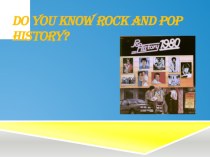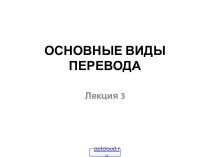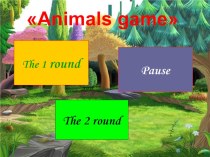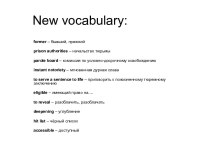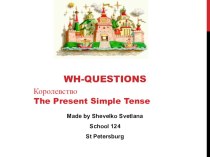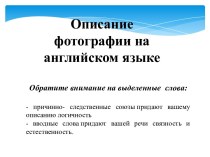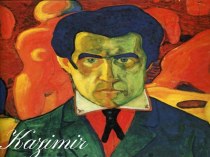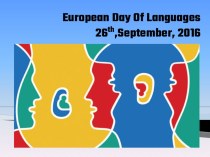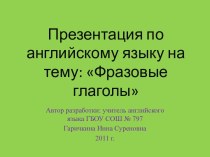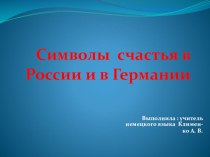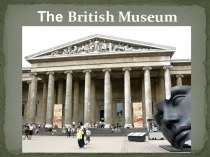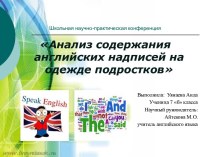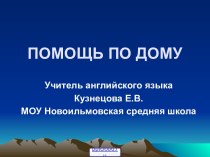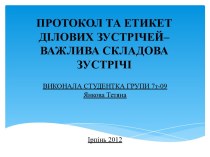- Главная
- Разное
- Бизнес и предпринимательство
- Образование
- Развлечения
- Государство
- Спорт
- Графика
- Культурология
- Еда и кулинария
- Лингвистика
- Религиоведение
- Черчение
- Физкультура
- ИЗО
- Психология
- Социология
- Английский язык
- Астрономия
- Алгебра
- Биология
- География
- Геометрия
- Детские презентации
- Информатика
- История
- Литература
- Маркетинг
- Математика
- Медицина
- Менеджмент
- Музыка
- МХК
- Немецкий язык
- ОБЖ
- Обществознание
- Окружающий мир
- Педагогика
- Русский язык
- Технология
- Физика
- Философия
- Химия
- Шаблоны, картинки для презентаций
- Экология
- Экономика
- Юриспруденция
Что такое findslide.org?
FindSlide.org - это сайт презентаций, докладов, шаблонов в формате PowerPoint.
Обратная связь
Email: Нажмите что бы посмотреть
Презентация на тему Lecture 5 Categories and types of present-day English and Ukrainian word-formation (part 2)
Содержание
- 2. Lecture 5Categories and types of present-day English
- 3. ...the game is to say something
- 4. Plan 1. Compounding
- 5. Productivityone of the productive means of word-formation
- 6. Ф DEFINITION A compound is a
- 7. Number and type of bases involvedIn principle
- 8. cohesion and integrity of a compoundThe structural
- 9. Formal aspectsIn English there are three forms
- 10. Formal aspectsModifying compounds are often hyphenated to
- 11. the structure of a compoundIn describing the
- 12. the structure of a compound This does not
- 13. The semantic integrity of a compoundis very
- 14. video
- 15. syntactic relationssemantic connections within compounds can be
- 16. Contrastive analysis of noun compounds Subject +
- 17. Contrastive analysis of noun compoundsdeverbal noun +
- 18. Contrastive analysis of noun compoundsObject + action:
- 19. Contrastive analysis of noun compoundsnoun (object) +
- 20. Contrastive analysis of noun compoundsverb + noun
- 21. Contrastive analysis of noun compoundsAction + adverbial:
- 22. Contrastive analysis of noun compoundsnoun (adverbial component
- 23. Summing upContrastive analysis of compound nouns in
- 24. ‘verbless’ compoundssilkworm, молокозавод (noun2 produces noun1),doorknob, лісостеп,
- 25. verbless compounds: subject and object[A]
- 26. verbless compounds: subject and object[D] ′DOORKNOB:
- 27. verbless compounds: subject and object[E] SECURITY
- 28. Combining-form compoundsPSYCHO -ANALYSIS: noun1 (in its combining
- 29. Stress patternsStress patterns are various and the
- 30. Bahuvrihi compondsThe term “bahuvrihi” refers not to
- 31. Bahuvrihi compondsa highbrow means ‘an intellectual’, on
- 32. back-formationSpeaking about compounding we should also mention
- 33. ReduplicativesSome compounds have two or more constituents
- 34. ReduplicativesThe most common uses of reduplicatives (sometimes
- 35. Скачать презентацию
- 36. Похожие презентации
Lecture 5Categories and types of present-day English and Ukrainianword-formation (part 2)Contrast is the occurance of different elements to create interest
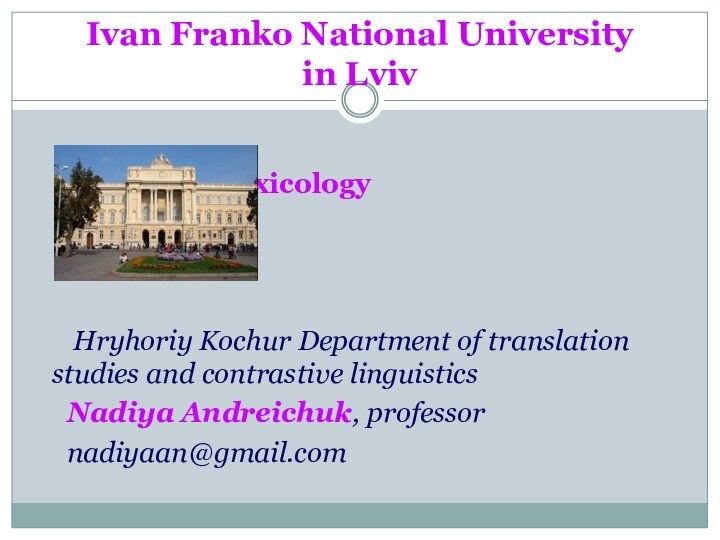








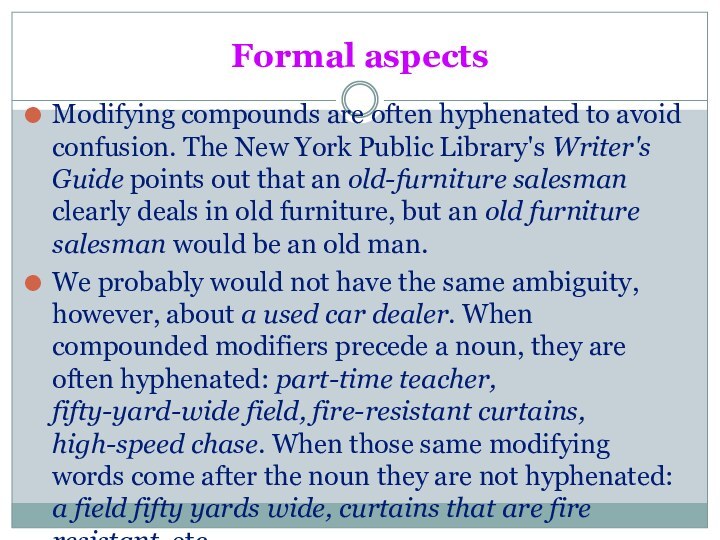


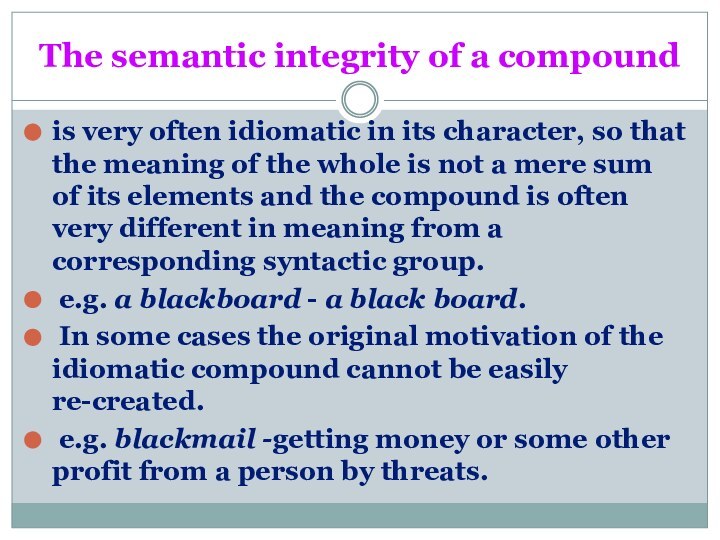

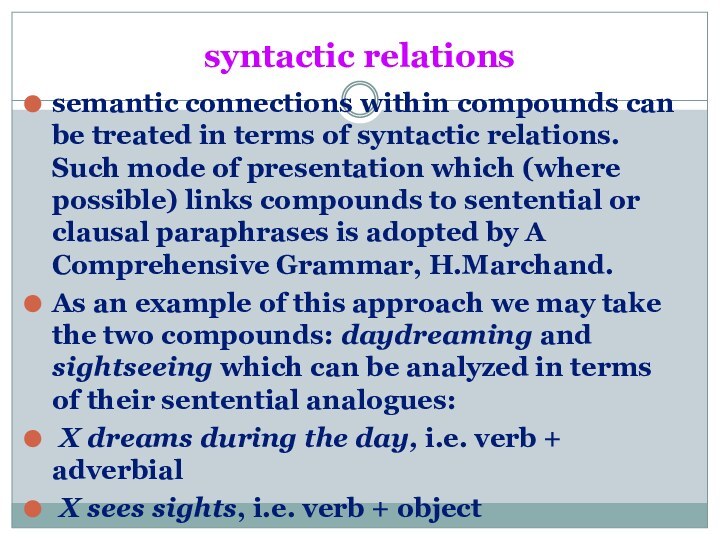
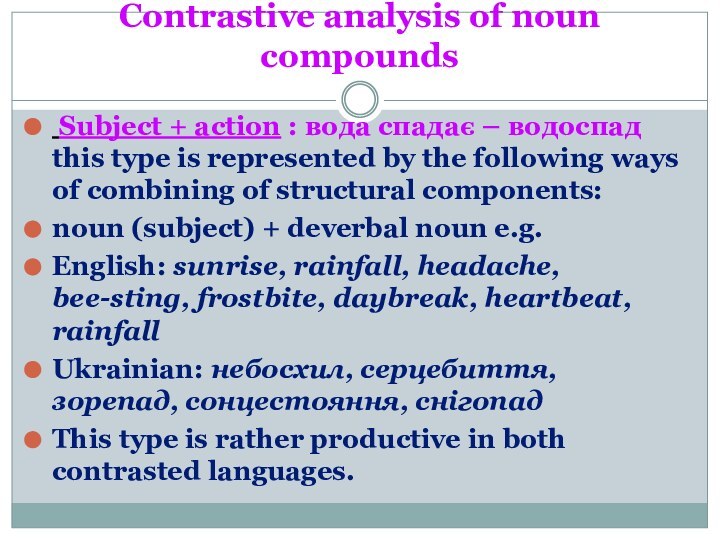
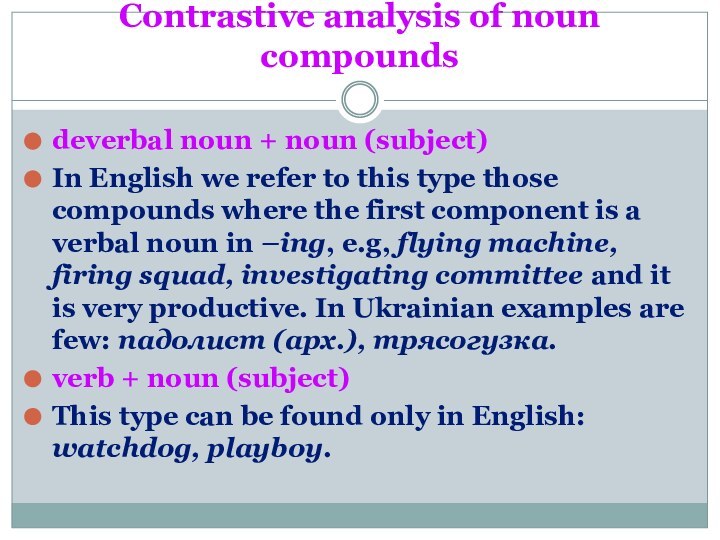

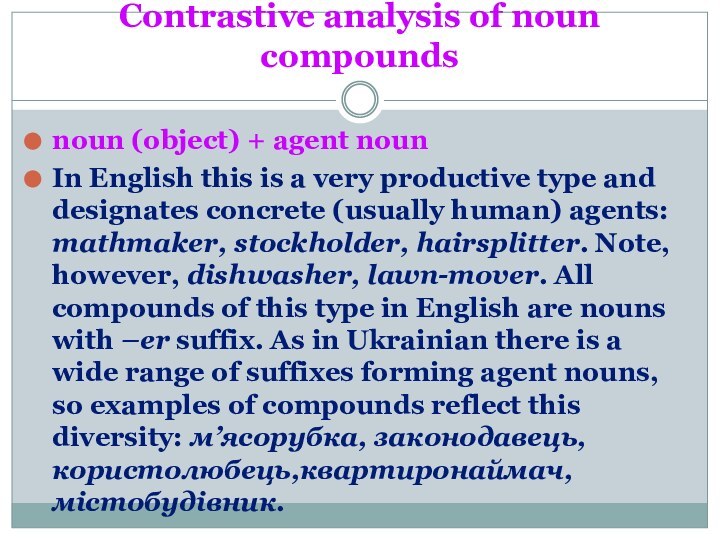
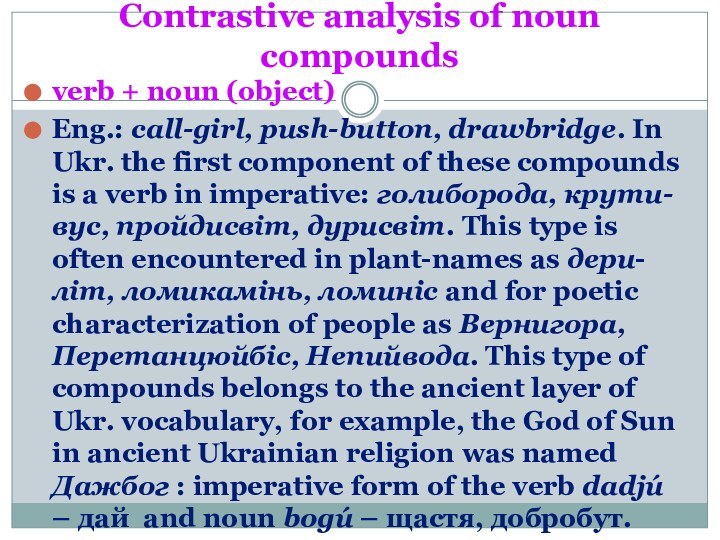
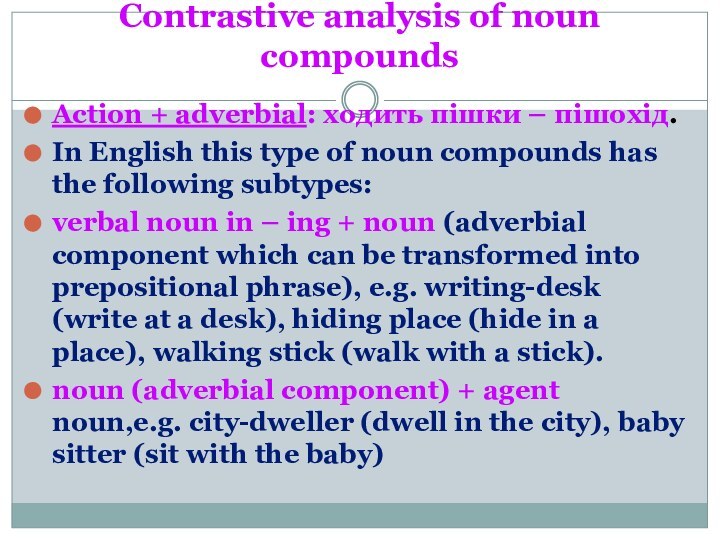
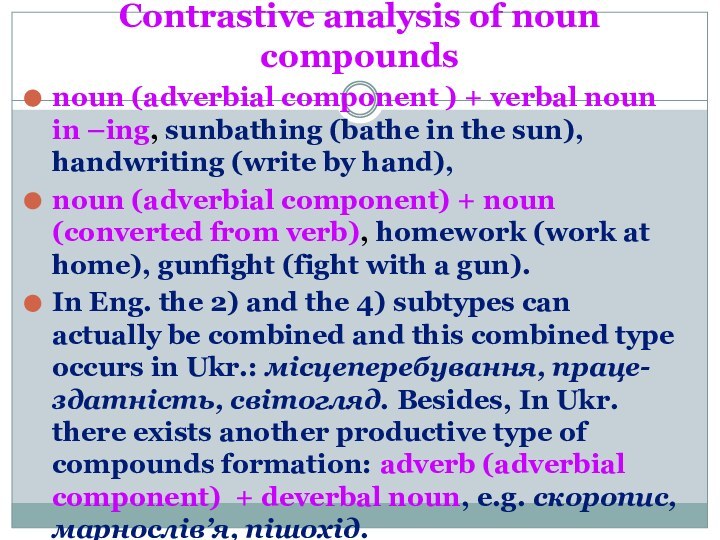


![Lecture 5 Categories and types of present-day English and Ukrainian word-formation (part 2) verbless compounds: subject and object[A] WINDMILL: noun1 + noun2 (noun1](/img/tmb/15/1466404/063db041ed4bc52e60d90cb00b7e7d6b-720x.jpg)
![Lecture 5 Categories and types of present-day English and Ukrainian word-formation (part 2) verbless compounds: subject and object[D] ′DOORKNOB: noun 1 + noun2 (noun1](/img/tmb/15/1466404/99d6fe193d253ff76223c3c15e663519-720x.jpg)
![Lecture 5 Categories and types of present-day English and Ukrainian word-formation (part 2) verbless compounds: subject and object[E] SECURITY OFFICER: noun1 + noun2 (noun2](/img/tmb/15/1466404/8dc87098ae5d14f466885870b49907f0-720x.jpg)
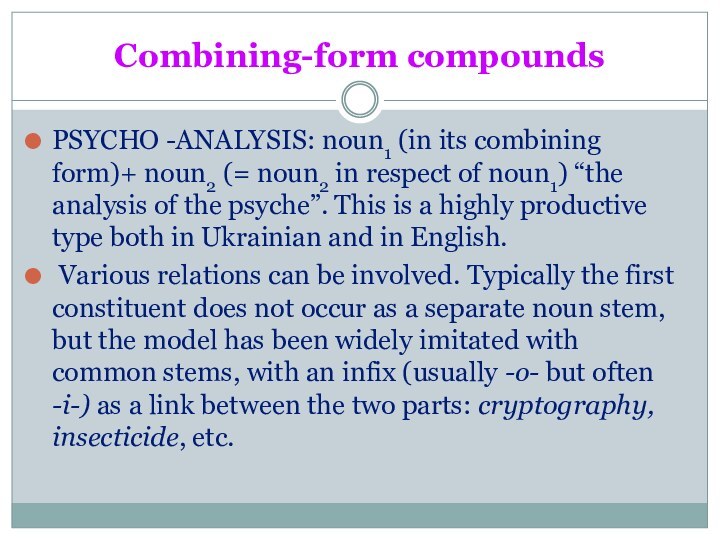

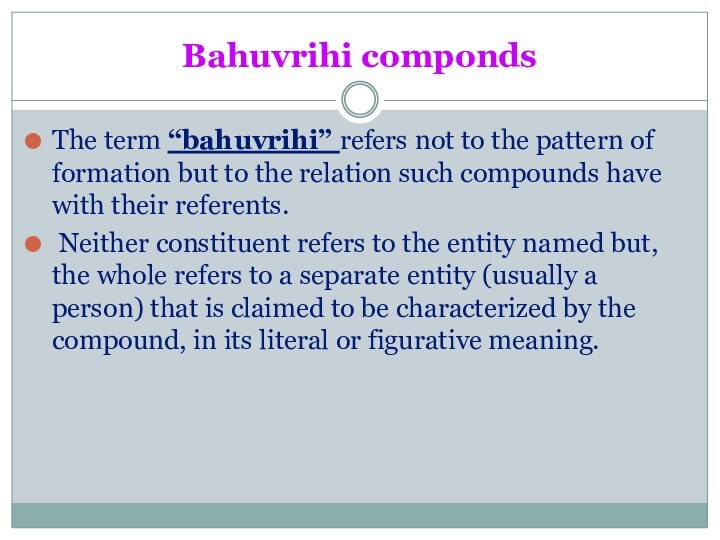
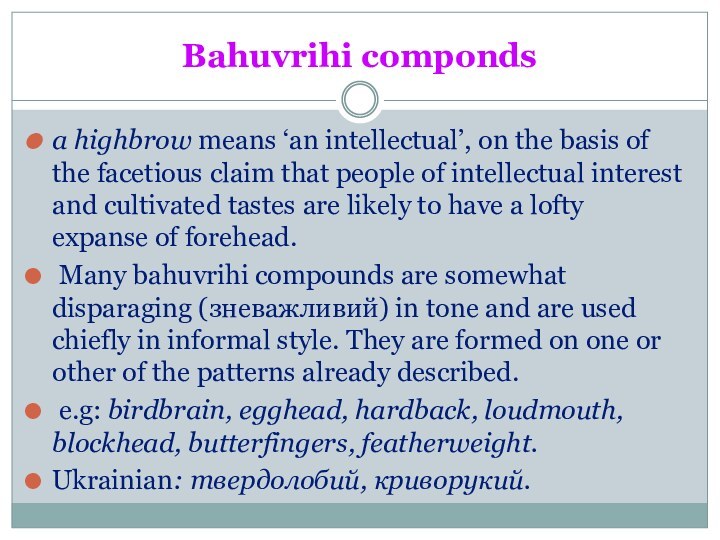
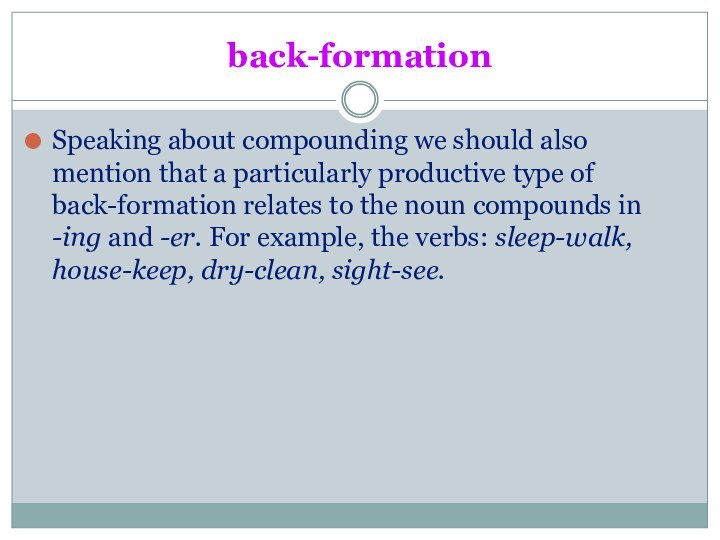
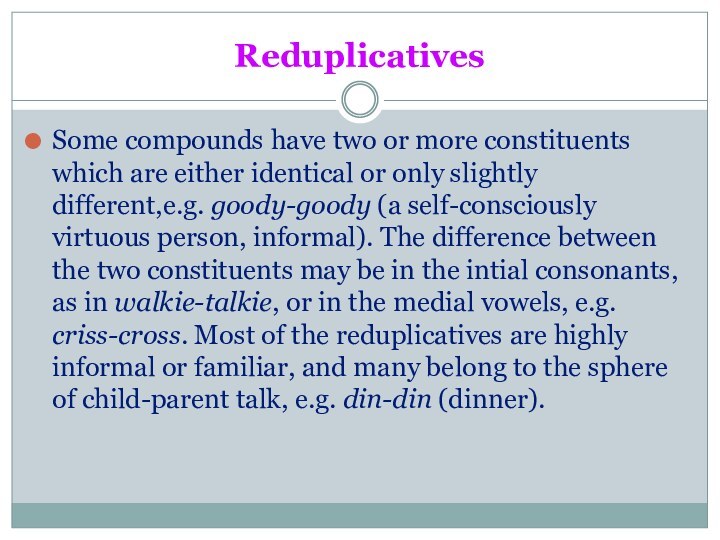
![Lecture 5 Categories and types of present-day English and Ukrainian word-formation (part 2) ReduplicativesThe most common uses of reduplicatives (sometimes called ‘jingles’) are:[i] to imitate](/img/tmb/15/1466404/f4ac61cc22b988509cb4287eb55f6150-720x.jpg)
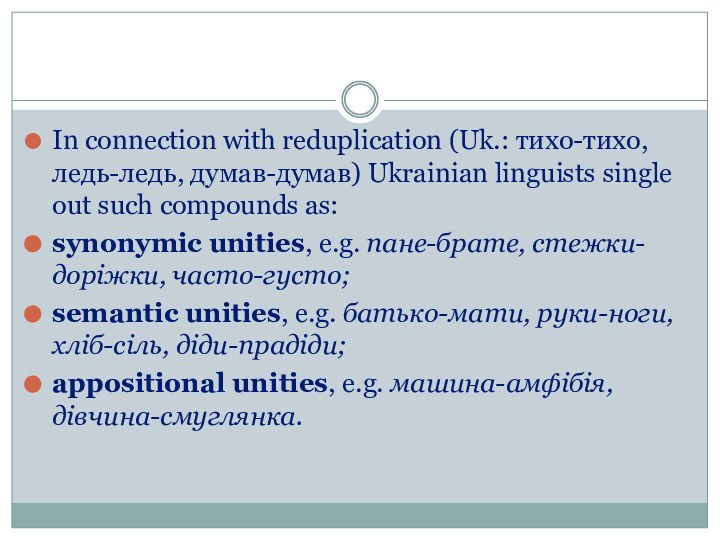
Слайд 4
Plan
1. Compounding
1.1. Formal characteristics
1.2.The treatment of compounds.1.3. Types of compounds
2 .Contrastive analysis of noun compounds in English and Ukrainian
2.1. Suggested classification in terms of syntactic paraphrase
2.2. “Bahuvrihi” compounds
2.3. Reduplicatives
Слайд 5
Productivity
one of the productive means of word-formation both
in English and in Ukrainian
is characterized by the
ease with which compound words are formed when need arises without becoming permanent units of the vocabularyshould be studied both diachronically and synchronically
TASKS:
1). The principal features of compounds which distinguish them from other linguistic units.
2). The semantic structure of compound words.
3). The principles of classification.
Слайд 6
Ф
DEFINITION
A compound is a lexical unit consisting of
more than one stem and functioning both grammatically and
semantically as a single word. I.V.Arnold states that these stems occur in English as free forms.In Ukrainian compounding is subdivided into
1. Stem-combining with the help of interfixes о, е (доброзичливий, працездатний) or without them (триповерховий, всюдихiд);
2. Word-combining or juxtaposition (Lat. juxta - near, positio - place) - combining several words or word-forms in one complex word (хата-лабораторiя, салон-перукарня)
Слайд 7
Number and type of bases involved
In principle any
number of bases may be involved, but in English
except for a relatively minor class of items (normally abbreviated) compounds usually comprise two stems only, however internally complex each may be.Compounding can take place within any of the word classes, but with very few exceptions, the resulting compound word in English is a noun, a verb or an adjective. In Ukrainian this list includes nouns, adjectives and adverbs.
Слайд 8
cohesion and integrity of a compound
The structural cohesion
and integrity of a compound may depend upon:
unity
of stress,solid or hyphanated spelling,
semantic unity,
unity of morphological and syntactic functioning
or, more often, upon the combined effect of several of these factors
Слайд 9
Formal aspects
In English there are three forms of
compound words:
the closed form, in which the words are melded
together, such as firefly, secondhand, softball, childlike, crosstown, redhead, keyboard, makeup, notebook;the hyphenated form, such as daughter-in-law, master-at-arms, over-the-counter, six-pack, six-year-old, mass-produced;
and the open form, such as post office, real estate, middle class, full moon, half sister, attorney general.
Слайд 10
Formal aspects
Modifying compounds are often hyphenated to avoid
confusion. The New York Public Library's Writer's Guide points out that
an old-furniture salesman clearly deals in old furniture, but an old furniture salesman would be an old man.We probably would not have the same ambiguity, however, about a used car dealer. When compounded modifiers precede a noun, they are often hyphenated: part-time teacher, fifty-yard-wide field, fire-resistant curtains, high-speed chase. When those same modifying words come after the noun they are not hyphenated: a field fifty yards wide, curtains that are fire resistant, etc
Слайд 11
the structure of a compound
In describing the structure
of a compound we should examine the relations of
the members to each other.Compounding associates stems drawn from the whole lexicon in a wide range of semantic relations. Although both bases in a compound are in principle equally open, they are normally in a relation whereby the first is modifying the second.
In short, compounding can in general be viewed as prefixation with open-class items. (A Comprehensive grammar, p. 1568)
Слайд 12
the structure of a compound
This does not mean
that a compound can be formed by placing any
lexical item in front of another. The relations between items brought together in compounding must be such that it is reasonable and useful to classify the second element in terms of the first. Such compounds are called endocentric.In exocentric compounds there is no semantic centre as in scarecrow (figure of a man in old clothes set up to scare birds away from crops). Only the combination of both elements names the referent.
Слайд 13
The semantic integrity of a compound
is very often
idiomatic in its character, so that the meaning of
the whole is not a mere sum of its elements and the compound is often very different in meaning from a corresponding syntactic group.e.g. a blackboard - a black board.
In some cases the original motivation of the idiomatic compound cannot be easily re-created.
e.g. blackmail -getting money or some other profit from a person by threats.
Слайд 15
syntactic relations
semantic connections within compounds can be treated
in terms of syntactic relations. Such mode of presentation
which (where possible) links compounds to sentential or clausal paraphrases is adopted by A Comprehensive Grammar, H.Marchand.As an example of this approach we may take the two compounds: daydreaming and sightseeing which can be analyzed in terms of their sentential analogues:
X dreams during the day, i.e. verb + adverbial
X sees sights, i.e. verb + object
Слайд 16
Contrastive analysis of noun compounds
Subject + action
: вода спадає – водоспад this type is represented
by the following ways of combining of structural components:noun (subject) + deverbal noun e.g.
English: sunrise, rainfall, headache, bee-sting, frostbite, daybreak, heartbeat, rainfall
Ukrainian: небосхил, серцебиття, зорепад, сонцестояння, снігопад
This type is rather productive in both contrasted languages.
Слайд 17
Contrastive analysis of noun compounds
deverbal noun + noun
(subject)
In English we refer to this type those compounds
where the first component is a verbal noun in –ing, e.g, flying machine, firing squad, investigating committee and it is very productive. In Ukrainian examples are few: падолист (арх.), трясогузка.verb + noun (subject)
This type can be found only in English: watchdog, playboy.
Слайд 18
Contrastive analysis of noun compounds
Object + action: вказує
дорогу – дороговказ
noun (object) + deverbal noun
This is a
moderately productive type in English but very common in Ukrainian, e.g.English: birth-control, handshake. Ukrainian: душогуб, сінокіс, гречкосій, родовід.
In Eng. we can single out a subtype noun (object) + verbal noun in – ing: book-keeping, town-planning. In Ukr. compounds of that subtype correspond to compounds in –ння: сироваріння, містобудування.
Слайд 19
Contrastive analysis of noun compounds
noun (object) + agent
noun
In English this is a very productive type and
designates concrete (usually human) agents: mathmaker, stockholder, hairsplitter. Note, however, dishwasher, lawn-mover. All compounds of this type in English are nouns with –er suffix. As in Ukrainian there is a wide range of suffixes forming agent nouns, so examples of compounds reflect this diversity: м’ясорубка, законодавець, користолюбець,квартиронаймач, містобудівник.
Слайд 20
Contrastive analysis of noun compounds
verb + noun (object)
Eng.:
call-girl, push-button, drawbridge. In Ukr. the first component of
these compounds is a verb in imperative: голиборода, крути- вус, пройдисвіт, дурисвіт. This type is often encountered in plant-names as дери- літ, ломикамінь, ломиніс and for poetic characterization of people as Вернигора, Перетанцюйбіс, Непийвода. This type of compounds belongs to the ancient layer of Ukr. vocabulary, for example, the God of Sun in ancient Ukrainian religion was named Дажбог : imperative form of the verb dadjú – дай and noun bogú – щастя, добробут.
Слайд 21
Contrastive analysis of noun compounds
Action + adverbial: ходить
пішки – пішохід.
In English this type of noun compounds
has the following subtypes:verbal noun in – ing + noun (adverbial component which can be transformed into prepositional phrase), e.g. writing-desk (write at a desk), hiding place (hide in a place), walking stick (walk with a stick).
noun (adverbial component) + agent noun,e.g. city-dweller (dwell in the city), baby sitter (sit with the baby)
Слайд 22
Contrastive analysis of noun compounds
noun (adverbial component )
+ verbal noun in –ing, sunbathing (bathe in the
sun), handwriting (write by hand),noun (adverbial component) + noun (converted from verb), homework (work at home), gunfight (fight with a gun).
In Eng. the 2) and the 4) subtypes can actually be combined and this combined type occurs in Ukr.: місцеперебування, праце-здатність, світогляд. Besides, In Ukr. there exists another productive type of compounds formation: adverb (adverbial component) + deverbal noun, e.g. скоропис, марнослів’я, пішохід.
Слайд 23
Summing up
Contrastive analysis of compound nouns in Eng.
and in Ukr. with syntactic paraphrase as tertium comparationis
reveals both isomorphic and allomorphic features in contrasted languages.
Слайд 24
‘verbless’ compounds
silkworm, молокозавод
(noun2 produces noun1),
doorknob, лісостеп, глинозем
(noun1 has noun2),
raindrop, скловата
(noun1 is of, consists of
noun2),ashtray, птахоферма, зерносховище
(noun2 is for noun1),
girlfriend, лісосмуга
(noun2 is noun1),
security officer
(noun2 controls/works in connection with noun1)
Слайд 25
verbless compounds:
subject and object
[A] WINDMILL: noun1 +
noun2 (noun1 powers/operates noun2 “the wind powers the mill”).
e.g.: air-brake, steam engine, gas cooker.[B] TOY FACTORY : noun1 + noun2 (noun2 produces/yields noun1, “the factory produces toys”). e.g.: honey-bee, silkworm, gold mine
Ukrainian: шовкопряд, нафтопромисел
[C] BLOODSTAIN: noun1 + noun2 (noun1 produces/yields noun2, “the blood produces stains”). e.g.: hay fever, tortoise-shell, whalebone, food poisoning.
Слайд 26
verbless compounds:
subject and object
[D] ′DOORKNOB: noun 1
+ noun2 (noun1 has noun2 “the door has a
knob”). This is a very productive type. Noun is inanimate. With animate nouns we use a noncompound genitive phrase: compare the table leg with the boy’s leg. e.g.: window-pane, cartwheel, bedpost.
Слайд 27
verbless compounds:
subject and object
[E] SECURITY OFFICER: noun1
+ noun2 (noun2 controls/works in connection with noun1 “The
officer looks after security”). e.g.: chairperson, fireman, deckhand. This is a very productive type, with the second constituent always a human agent. Indeed, so commonly has man been thus used (in its unmarked gender role, “human adult”) that in some compounds it has a reduced vowel /men/. This item and its gender-free alternative person might be viewed as a suffix. In Ukrainian terminology some final elements of compounds are called suffixoids : -грiйка, думець, -лов. e.g.: тiлогрiйка, однодумець, птахолов.
Слайд 28
Combining-form compounds
PSYCHO -ANALYSIS: noun1 (in its combining form)+
noun2 (= noun2 in respect of noun1) “the analysis
of the psyche”. This is a highly productive type both in Ukrainian and in English.Various relations can be involved. Typically the first constituent does not occur as a separate noun stem, but the model has been widely imitated with common stems, with an infix (usually -o- but often -i-) as a link between the two parts: cryptography, insecticide, etc.
Слайд 29
Stress patterns
Stress patterns are various and the primary
stress often falls on the link vowel of the
combining form. Among common second constituents are -meter,-graph(y), -gram, -logy. In Ukrainian: -метр(iя), -граф(iя), -лог(iя), -ман(iя). The formations are especially in the fields of science and learning. In consequence, many are in international currency, adopted or adapted in numerous languages.
Слайд 30
Bahuvrihi componds
The term “bahuvrihi” refers not to the
pattern of formation but to the relation such compounds
have with their referents.Neither constituent refers to the entity named but, the whole refers to a separate entity (usually a person) that is claimed to be characterized by the compound, in its literal or figurative meaning.
Слайд 31
Bahuvrihi componds
a highbrow means ‘an intellectual’, on the
basis of the facetious claim that people of intellectual
interest and cultivated tastes are likely to have a lofty expanse of forehead.Many bahuvrihi compounds are somewhat disparaging (зневажливий) in tone and are used chiefly in informal style. They are formed on one or other of the patterns already described.
e.g: birdbrain, egghead, hardback, loudmouth, blockhead, butterfingers, featherweight.
Ukrainian: твердолобий, криворукий.
Слайд 32
back-formation
Speaking about compounding we should also mention that
a particularly productive type of back-formation relates to the
noun compounds in -ing and -er. For example, the verbs: sleep-walk, house-keep, dry-clean, sight-see.
Слайд 33
Reduplicatives
Some compounds have two or more constituents which
are either identical or only slightly different,e.g. goody-goody (a
self-consciously virtuous person, informal). The difference between the two constituents may be in the intial consonants, as in walkie-talkie, or in the medial vowels, e.g. criss-cross. Most of the reduplicatives are highly informal or familiar, and many belong to the sphere of child-parent talk, e.g. din-din (dinner).
Слайд 34
Reduplicatives
The most common uses of reduplicatives (sometimes called
‘jingles’) are:
[i] to imitate sounds, e.g. rat-a-tat [knocking on
door], tick-tock [of clock], ha-ha [of laughter], bow-wow [of dog]
[ii] to suggest alternating movements, e.g. seesaw, flip-flop, ping- pong.
[iii] to disparage by suggesting instability, nonsense, insincerity, vacillation (вагання) etc.: higgledy-piggledy, hocus-pocus, wishy-washy, dilly-dally, shilly-shally.
[iv] to intensify, e.g. teeny-weeny, tip-top.





